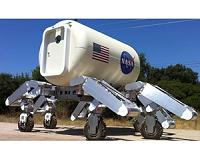 |
Washington (AFP) Aug 3, 2010 Neil Armstrong, who turns 80 on Thursday, became the first human to set foot on the moon on July 20, 1969, before the eyes of hundreds of millions of television viewers worldwide, who gazed in awe. With one small step off a ladder, Armstrong placed mankind's first footprint on an extraterrestrial world and gained instant hero status. His first words upon stepping on the lunar surface have since been etched in history: "That's one small step for man, one giant leap for mankind." An estimated 500 million people watched the grainy black and white broadcast that showed Armstrong, clad in a white space suit, climb down the lunar lander's ladder onto the moon's desolate surface. As commander of the Apollo 11 mission, it was also Armstrong who had notified mission control that the module had made a successful arrival. "Houston, Tranquility base here. The Eagle has landed." Joined by fellow astronaut Buzz Aldrin, Armstrong spent about two and a half hours exploring the landscape around the landing site. He described the surface as being like powdered charcoal. "I can pick it up loosely with my toe," he said. Armstrong and Aldrin gracefully bounced in slow-motion despite their clumsy space suits, getting a first feel for the moon's gravity, which is one sixth that of Earth. The two moonwalkers took photographs, collected rock and soil samples and deployed scientific instruments. They also planted a US flag and placed a plaque stating: "Here men from the planet Earth first set foot upon the moon. We came in peace for all mankind." The astronauts returned to Earth on July 24, ending the celebrated Apollo 11 mission, Armstrong's second and last venture into space. In September 1966, Armstrong had flown with David Scott on the Gemini 8 mission that linked up with the unmanned Agena Target Vehicle in the first ever docking of two spacecraft. Born in Wapakoneta, Ohio on August 5, 1930, Armstrong had an early fascination with aircraft and worked at a nearby airport as a teenager. He took flying lessons at the age of 15 and received his pilot's license on his 16th birthday. A US Navy aviator, he flew 78 missions in the Korean War. He studied aeronautical engineering at Purdue University in Indiana, and later earned a Master of Science degree in aerospace engineering at the University of Southern California. In 1955, he became a test pilot at the High-Speed Flight Station at Edwards Air Force Base in California, where he flew about 50 different types of aircraft. Seven years later, Armstrong was selected by the National Aeronautics and Space Administration to train as an astronaut in Houston, Texas. He has lived more than half his life in the aftermath of those golden moments walking on the moon. After retiring from NASA in 1971, Armstrong taught aerospace engineering at the University of Cincinnati for nearly a decade and served on the boards of several companies, including Lear Jet, United Airlines and Marathon Oil. Despite his worldwide fame, the lunar pioneer shunned the limelight. In a rare interview in 2005, Armstrong told the CBS network that he didn't deserve the attention he received for being the first man on the moon. "I wasn't chosen to be first. I was just chosen to command that flight. Circumstance put me in that particular role." Armstrong has faced his share of controversy. For decades he was thought to have flubbed his first words spoken on the moon, by dropping the "a" in speaking of a small step "for man." It was 37 years later that an Australian expert said high-tech analysis of the static-ridden transmission found the missing adjective, and that history should remember Armstrong saying what he had intended: "That's one small step for a man, one giant leap for mankind." This year he publicly lashed out at President Barack Obama's decision to axe NASA plans to return to the moon, describing the move as "devastating" to the US space program. Budget plans unveiled early this year proposed scrapping the Constellation program, which was developing a new rocket to take Americans back to the moon, and giving private industry the role of building the space vehicles to take humans to the International Space Station. The iconic explorer also denied claims by conspiracy theorists that the lunar landing was a giant hoax or that he became a Muslim after hearing the Islamic call to prayer on the moon.
Share This Article With Planet Earth
Related Links Mars News and Information at MarsDaily.com Lunar Dreams and more
 NASA's ATHLETE Warms Up For High Desert Run
NASA's ATHLETE Warms Up For High Desert RunPasadena CA (JPL) Aug 02, 2010 Pasadena CA (JPL) Aug 02, 2010 Engineers from NASA's Jet Propulsion Laboratory are currently putting their All-Terrain, Hex-Limbed, Extra-Terrestrial Explorer (ATHLETE) through a series of long-drive tests on the long, dirt roads found adjacent to JPL. The JPL grounds do not include an unpaved area of sufficient size for testing such a large robot over a long distance. Some of the d ... read more |
|
| The content herein, unless otherwise known to be public domain, are Copyright 1995-2010 - SpaceDaily. AFP and UPI Wire Stories are copyright Agence France-Presse and United Press International. ESA Portal Reports are copyright European Space Agency. All NASA sourced material is public domain. Additional copyrights may apply in whole or part to other bona fide parties. Advertising does not imply endorsement,agreement or approval of any opinions, statements or information provided by SpaceDaily on any Web page published or hosted by SpaceDaily. Privacy Statement |